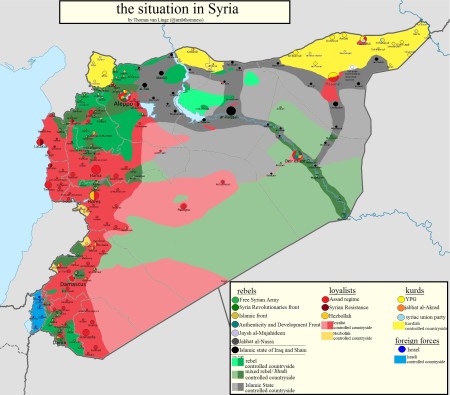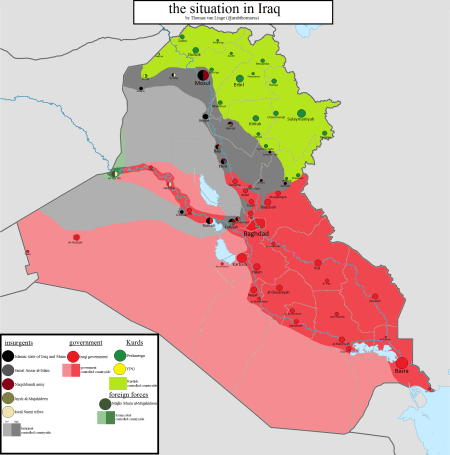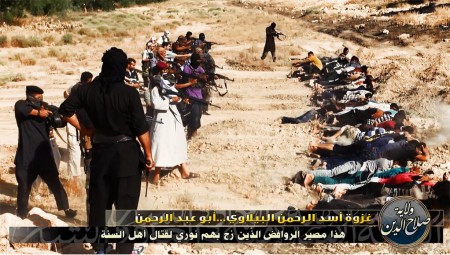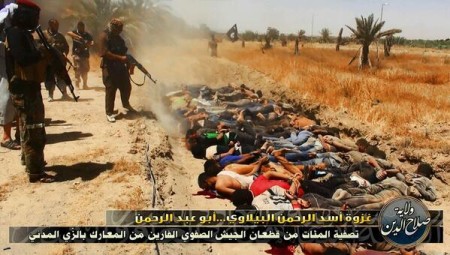Sinjar Was Only the Beginning—by Matthew Barber
Posted by Matthew Barber on Friday, August 8th, 2014
Sinjar Was Only the Beginning
 by Matthew Barber
by Matthew Barber
The calm is slowly unraveling in Kurdistan, and a growing, pervasive anxiety is beginning to afflict us all.
We know that the fighting between the Kurdish Peshmerga forces and the Islamic State jihadis continues to develop and move from place to place, but we’re never exactly sure what’s happening, where the fighting is occurring, or who has the upper hand. News—both local and international—has proved highly unreliable since this crisis began on Sunday.
If it’s not happening on your block, you probably don’t really know what’s going on.
The Case of Shariya
The Yazidi town of Shariya, located a few miles south of Dohuk, is a “collective village” created by Saddam Hussein during his Arabization program in the 1970s. Saddam bulldozed countless Yazidi towns until there was nothing left but gravel, and then forcibly moved their former inhabitants into collectives situated in locations that served his strategic interests. Shariya lies in the center of a valley ringed by hills, along the bases of which were originally a number of Yazidi villages. Saddam destroyed all of these villages (fearing that their proximity to the mountains would facilitate the harboring of Peshmerga fighters) and huddled all the villagers together in the center of the open plain between the mountains, where they would be much easier to keep an eye on.

A view of Shariya with hills behind—photo: Matthew Barber/Syria Comment
Shariya had a population of 17,000 until Sunday’s crisis in Sinjar began compelling families to flee for the Dohuk governorate. By Wednesday, Shariya had a population of over 80,000 people.
When I visited the community on Monday, it was already bursting at the seams, and it wasn’t even close to the peak it reached on Wednesday.
The road leading into Shariya was a non-stop caravan of vehicles transporting more passengers than one would have thought possible: small trucks carrying dozens, packed into the truck beds like livestock; small cars with 3, 4, 5 people crammed into the trunks—all having traveled like this for hours, or even overnight due to the bottlenecking effect that the sudden flight of more than 200,000 (perhaps closer to 300,000) had on the road from Sinjar.

Yazidis flee Sinjar in overcrowded car, barefoot—photo: Matthew Barber/Syria Comment

Yazidis flee Sinjar in overcrowded car, barefoot—photo: Matthew Barber/Syria Comment
On our way to the village, a friend and I stopped and helped transport Yazidis from Sinjar that we noticed were just sitting on the side of the road, unsure how to reach Shariya.
Inside the little town, thousands thronged about, trying to secure food, water, and shelter. I saw entire families sleeping on the floors of stores, offices, school buildings, a hospital-cum-motel, and the roofs of houses. The local residents worked like bees to coordinate aid to all of the families. The KRG (Kurdish Regional Government) sent in trucks loaded with food and water, and Muslim families from neighboring communities brought deliveries of food to distribute among the displaced Yazidis.
People began to come up to me, wanting to talk about what had happened. Uncertainty and bewilderment clouded each face. (I was told only yesterday that no foreign journalists visited Shariya; aside from some observers with Amnesty International and HRW, I was the only foreigner to visit the community.)
A man approached me and asked if I worked with the UN. “No, I don’t, but I may write some reports about the situation here,” I replied. “Can I talk to you?” he asked. “Certainly,” I said.
“Well, if you don’t mind, I would like to tell you about what happened to me—”
As he finished his sentence, his voice broke and he burst into tears. Unable to suppress a brief wail, he buried his face in the crook of his arm and, seemingly ashamed, quickly walked a few paces away, put his face against the wall of a nearby building, and stood sobbing. I walked over, put my hand on his shoulder, and stood by silently while his grief found its much-needed release. When he had regained his composure, a Kurdish friend and I brought some chairs and sat to listen to his story.
His name was Osman. He recounted how the day before, when IS jihadists attacked his home village in the Sinjar mountains, he was out working. “My two daughters were our relatives’ home. I couldn’t get to them and they left by a different way.”
In the moment of crisis, when Peshmerga lines broke, people fled in all different directions. There was no time to coordinate an escape; in this way many families became separated from each other.
Devastated at not knowing what transpired for his two girls, ages 3 and 7, Osman continued: “I don’t think they made it out of Sinjar; I think they are trapped there with the others. I don’t know if they are alive or not.”
While fleeing, Osman saw bodies along the road that had been shot by IS fighters. People recounted seeing the corpses of women shot on the roadside, and one even described coming upon a stranded vehicle containing the dead bodies of a mother and her children, shot to death inside it.
In my conversation with Osman, it struck me that I was encountering the pain of just one man among several hundred thousand new refugees in the Dohuk governorate, each with a unique story.
When our conversation ended, Osman said, “I ask the world for help, not for myself, but for those still stuck in Sinjar.”
For a few years, the Yazidis of Shariya have been working to rebuild their nearby destroyed villages. The partially-completed houses are often just cement shells without windows or doors, but the residents of Shariya tried to settle the fleeing families inside of them, after the homes of Shariya itself were overwhelmed by the new guests.
This is photo of one of the rebuilt villages in-progress, taken some time before this crisis. Many families have taken shelter inside such structures:

A Yazidi village, previously destroyed by Saddam Hussein, in the process of being rebuilt—Photo: Matthew Barber/Syria Comment
To transport large numbers of people amidst this chaos, creative means was employed, such as carrying them in dump trucks:

Photo: Matthew Barber/Syria Comment
The New Crisis
When I visited Shariya on Monday, it looked like this:

Photo: Matthew Barber/Syria Comment
By Wednesday, volunteers had registered over 63,000 displaced individuals (more had arrived and not registered). This was just one of several primary destinations for Sinjar’s refugees. I was informed by local relief coordinators that the needs of the refugees were beginning to exceed what the KRG and NGOs were able to provide.
But when I returned yesterday, something unbelievable had happened. Shariya was almost a ghost town… as silent as the grave.

Photo: Matthew Barber/Syria Comment
I found a few lingering volunteers and asked, “What happened here?” They replied, “Everyone fled this morning—the refugees as well as the local population of Shariya. Of approximately 80,000 people living here yesterday, only a couple hundred remain.”
This unbelievable second exodus is the result of a sense of panic that is washing across the Dohuk governorate. I had begun to sense it on Tuesday, while receiving panicked calls from Yazidis fleeing to Turkey. What initially prompted the stampede was the decision of many Yazidis in villages near Mosul—close to the further limit of Peshmerga-controlled territory—to leave and move northward, anticipating IS attacks in their area. Though IS hadn’t broken through Kurdish lines and no Yazidi villages had been infiltrated, fighting was taking place (and continues until now) between the Peshmerga and IS near the Mosul Dam and along the “border” with Mosul, and many Yazidis in those locations became fearful that what had just taken place in Sinjar might transpire in their areas as well.
Witnessing the ethnic cleansing of Sinjar, and sensing that an intentional campaign of extermination was being directed against them, Yazidis no longer felt secure about Peshmerga defensive capabilities and decided not to take any chances.
As waves of people from the southernmost villages began to arrive in villages a little closer to Dohuk (including Shariya), rumors began to circulate that Kurdish defenses had already been breached. I witnessed what verged upon mass hysteria as the local residents of villages near Dohuk decided to flee to Turkey. Those with passports and visas left; others tried to go as far north as possible, if they knew people who would take them in.
 This helpful map image, created several years ago by “Bluebird Research,” shows the Yazidi villages of Sheikhan & Dohuk (in blue) and of Sinjar (in red—“Sincar” on the map). It is useful to see these communities in relation to each other, Erbil, Mosul, Dohuk, and the Syrian border. Access the map directly to zoom and see the location of individual villages (including Shariya).
This helpful map image, created several years ago by “Bluebird Research,” shows the Yazidi villages of Sheikhan & Dohuk (in blue) and of Sinjar (in red—“Sincar” on the map). It is useful to see these communities in relation to each other, Erbil, Mosul, Dohuk, and the Syrian border. Access the map directly to zoom and see the location of individual villages (including Shariya).
Families prioritized the departure of their female members, with some men staying behind in case the need to defend arose. A number of reports have emerged of IS fighters kidnapping large groups of women and carting them off in trucks. On Tuesday I encountered one woman in tears after her friend received a call that a kidnapped woman in Sinjar managed to make from inside one of the trucks. She was able to keep her phone with her and apprised her family of what was happening. Throughout the course of the Syrian conflict and its recent expansion into Iraq, accusations have frequently surfaced regarding women taken as a kind of religiously-sanctioned booty. Jihadists deny this, claiming women are taken prisoner as bargaining chips. Regardless, documentation exists of the occurrence, during the Iraq War period of al-Qaida violence targeting Yazidis, of Yazidi women being kidnapped, forced to convert, and forced into marriages with Muslims. That this precedent exists obviously makes the community very sensitive to the current situation.
The panic was unsettling, but I couldn’t confirm any reports of IS incursions into Kurdistan. But the Yazidi rationale was: We need to get out now before something bad happens and people storm the border, prompting the Turks to close it. These fears were justified: the Turks have allegedly closed the border crossing near Zakho at 8:00 pm last night after receiving a huge influx of fleeing people.
But few of the many thousands of refugees from Sinjar have the means to travel abroad.
Last night, sitting in the quiet dark of Shariya, I asked community leaders where all the refugees—plus the town’s own population—could have disappeared to. “Into the mountains, north to Amadiya, to Zakho, to Erbil, to anywhere.” Nobody really knows. But the humanitarian crises that engulfed Shariya for several days will merely be transplanted elsewhere. When the people were concentrated in one place, it was possible to coordinate relief efforts. Now that people are spreading across the governorate and beyond in panic, it will be even more difficult to meet the humanitarian need.

USAID being distributed in Shariya, Kurdistan—Photo: Matthew Barber/Syria Comment

Water bottles discarded in Shariya in the wake of Sinjar IDPs’ second flight, Aug 7, 2014—Photo: Matthew Barber/Syria Comment
Though you could hear a pin drop in Shariya last night, I had a nagging feeling that the exit of refugees wouldn’t work. Where else would they be able to find the same kind of organized relief efforts that were performed in Shariya? Sure enough, beginning this morning, the same refugees that fled Shariya yesterday have started to stream back in. What we’re seeing now is the frantic movement of people from one place to the next, running in circles like a panicked hiker lost in the woods.
This fear is affecting more than the Yazidi community; many Christians are also trying to leave the country. Since the first day ISIS entered Mosul, refugee movement into Kurdistan has not ceased, and eventually all of Mosul’s Christians fled here after being expelled. Compounding the tragedy for Christians, IS yesterday attacked the Christian town of Qaraqosh, leading to another mass-displacement of many thousands. Add to this the displacement of Sinjar’s population, and increased fighting in Tel Kayf near Mosul: It’s understandable why I’m hearing Christians echo one consistent sentiment: “I don’t want to live here anymore.”
I’ve followed terrorism-related issues for years, but this environment has schooled me anew in the realities of terror. The local contagion of fear demonstrates what a potent weapon terror is, when instrumentalized by an entity like IS.
However, the current attitude of many Muslims here differs significantly from that of the minorities. In fact, it amazes me the degree to which separate communities here, living side by side, can exist in such strikingly different mental space. I have found that my own mental reality here is greatly determined by those with whom I spend time. After half an hour chatting with Muslims, I’m comfortably convinced that Dohuk is safe, Erbil will remain impenetrable, Peshmerga are making advances by the hour, and overall there’s nothing to worry about. After a half hour chatting with Yazidis or Christians, I find myself furtively glancing up and down the streets expecting IS jeeps to appear, planning my escape route out of the country, and generally anticipating the imminent end of the world.
Today I spoke via telephone with Christians who are so terrified that they will not leave their houses to even move about Dohuk. I later went out and interacted with Muslims, who were nonchalantly conducting business as usual, and who were happy to discuss the day’s news with me, emphasizing the imperviousness of our location.
The divergence of perspectives between the communities is striking. How can Kurdish Muslims feel so at ease while Christians and Yazidis tremble with so much fear, the same place? It can be explained as the intimate knowledge of a kind of virulent personal enmity intent upon erasing one’s kind from the planet. When you know that an enemy’s sworn purpose is to kill you and wipe out yours—not merely over profit or resources, but because you are inherently wrong—a sense of vulnerability develops that others, who do not share the experience, cannot relate to.
Though the safety of Dohuk has remained integral until now, it wouldn’t be correct to frame minorities as those who are the most disconnected from reality. That Qaraqosh, Iraq’s largest Christian city, was taken over by IS yesterday (or at least attacked, if not fully occupied—conflicting reports), displacing another 50,000 – 100,000 Christians (reported numbers conflict), this time to Erbil, fully validates the kind of infectious trepidation that’s afflicting the minorities. And yet, for some Muslims I’ve spoken to in the city, it seems like a non-item. I don’t mean there’s a lack of compassion—we’ve seen plenty toward Yazidis, and perhaps these kinds of events are by now just too ordinary for some—but this is a significant event. Qaraqosh is southeast of Mosul, inside Kurdish-controlled territory, in the direction of Erbil. As in Sinjar, IS again broke through Peshmerga defenses and displaced a minority. It’s no surprise that Christians and Yazidis can now be frequently heard saying “I no longer have confidence in the Peshmerga.” Not only is that kind of breach scary and serious, the number of new refugees (going with the higher estimate) is close to half of those displaced in Sinjar. For residents to shrug this off as irrelevant to Dohuk is to disengage from reality to at least the same degree as those running wild with exaggerated fears.

Final stragglers flee Shariya at night, Aug 7, 2014—Photo: Matthew Barber/Syria Comment
What Comes Next?
At dusk in Shariya last night, while discussing rumors that Obama would take action to save those stranded for days without food or water in Sinjar, I glimpsed two military helicopters some distance away flying south. When I pointed them out to my Kurdish companions, there were reactions of elation. “They are taking supplies to Sinjar! And maybe bombing Da’esh too!” It’s interesting to be in the Middle East and witness a joyful reaction to the prospect of US action—not a typical experience.
But this morning, hopes do not seem to have improved among Yazidis. Rather, many reports have apparently come in overnight of people dying in large numbers in Sinjar. The entrapment of the populations there, without foodstuffs or hydration, began on Sunday, and it is no surprise that many would be dying four days later. Though action on the 5th day was welcomed, some fear it is too late, and I am hearing expressions of anger toward Obama from some Yazidis. There may have been some supply drops earlier, but it is not clear how many people were able to be reached with aid.
Others are encouraged by Obama’s decision to carry out airstrikes against jihadists attempting to invade Kurdish-controlled areas, though reports have varied—and conflicted—about exactly what places have seen US airstrikes today, aside from Sinjar.
Regardless of whatever progress the airstrikes in Sinjar can accomplish, the battle has heated up in areas north of Mosul, east of Mosul, the area between Mosul and Erbil, and areas between Erbil and Kirkuk, in addition to ongoing fighting over the dam.
The problem for all of us here is the inability to receive timely, accurate notification about developments in the fighting, even within areas not too far from us. The poor quality of reporting (by both Kurdish and international media) in this situation has been surprising. On Monday, all major international media were reporting that the Mosul Dam had been taken by IS. I sat with a friend who called dam employees—working on site at the dam—who told us “We are here, working at the dam right now, and the Peshmerga are in control of it.” It never fell out of Peshmerga hands, even though IS has been battling them in the town of Wana, 7km south of the dam, to gain control of it. Yesterday morning, new reports that the dam had fallen (presented as a “first-time event,” not acknowledging the same reporting a few days earlier) began appearing again. We called again and were told that the dam was under Peshmerga control. Today there are—once again—fresh reports that IS has taken the Mosul Dam. I haven’t called anyone yet; maybe they finally did take it after all. Local people are as in the dark as anyone else, unless they can make a call to someone at the locus of activity.
I will venture to say that it is very unlikely that IS has the dam.
Compounding the problem is that Twitter, Facebook, and YouTube have been blocked in Kurdistan since yesterday afternoon. The sense is that this was a measure to prevent Peshmerga positions from being given away ahead of a major military response to IS, presumably underway now with the aid of the American air force. Unfortunately, this makes it very difficult for us to know what is happening here, because we cannot share information with each other easily, nor can we inform people outside as to what is taking place. Though unable to tweet since yesterday, this post will—hopefully—convey a sense of what the atmosphere in the Dohuk governorate has been like.
How good or bad is the situation? As bad as the minorities fear or as good as the majority maintains? The reality is probably somewhere in the middle. One thing is certain: Sunday’s events in Sinjar now mark the beginning of an unfolding saga, leading toward an unknown conclusion.










































































































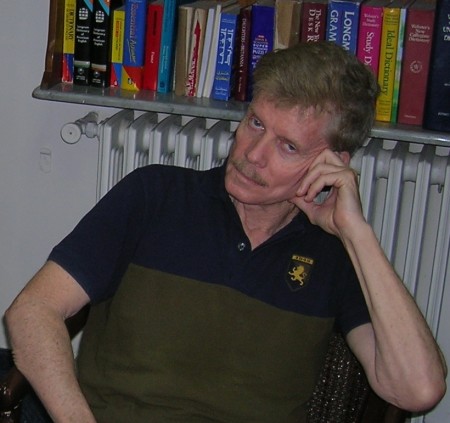 Stephen Boeshaar worked throughout the Arab World for many years and is fluent in Syrian Arabic. After serving with the Peace Corps in Morocco in the 1960s, he ran English language instruction programs in Yemen, Oman, Bahrain, and Syria, and worked with Fulbright in Egypt developing university curriculum. Later, Steve directed the American Language Center in Damascus for 20 years, until the Syrian uprising finally compelled him to leave with his family in 2012. He currently lives in Florida and is working on a collection of “Syrian Profiles,” stories of the many lives he encountered along his path. The following is an excerpt. Steve hopes to complete the book later this year. He can be contacted at
Stephen Boeshaar worked throughout the Arab World for many years and is fluent in Syrian Arabic. After serving with the Peace Corps in Morocco in the 1960s, he ran English language instruction programs in Yemen, Oman, Bahrain, and Syria, and worked with Fulbright in Egypt developing university curriculum. Later, Steve directed the American Language Center in Damascus for 20 years, until the Syrian uprising finally compelled him to leave with his family in 2012. He currently lives in Florida and is working on a collection of “Syrian Profiles,” stories of the many lives he encountered along his path. The following is an excerpt. Steve hopes to complete the book later this year. He can be contacted at 
